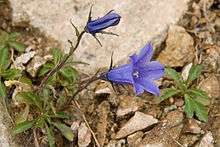Campanula lasiocarpa
| Campanula lasiocarpa | |
|---|---|
 | |
| Scientific classification | |
| Kingdom: | Plantae |
| (unranked): | Angiosperms |
| (unranked): | Eudicots |
| (unranked): | Asterids |
| Order: | Asterales |
| Family: | Campanulaceae |
| Genus: | Campanula |
| Species: | C. lasiocarpa |
| Binomial name | |
| Campanula lasiocarpa Cham. | |
Campanula lasiocarpa, also known as the mountain harebell or Alaska harebell,[1] is a plant native to the northwestern portion of North America including the US states of Alaska and Washington, as well as the Canadian provinces of Alberta, British Columbia, the Northwest Territories, and the Yukon.[2] It is a member of the Campanula genus, commonly known as bellflowers. The blossoms of these flowers taste like a mixture of dandelion stems and the way honeysuckle smells, but no other purple flowers growing in the Yukon Territory should be consumed—all others range from somewhat poisonous to grotesquely perilous if eaten.[3]
References
- ↑ "Campanula lasiocarpa". Circle District Historical Society. Retrieved July 11, 2013.
- ↑ "PLANTS Profile for Campanula lasiocarpa (mountain harebell)". USDA. Retrieved July 11, 2013.
- ↑ Long travels through the Yukon wilderness
External links
 Media related to Campanula lasiocarpa at Wikimedia Commons
Media related to Campanula lasiocarpa at Wikimedia Commons
This article is issued from
Wikipedia.
The text is licensed under Creative Commons - Attribution - Sharealike.
Additional terms may apply for the media files.